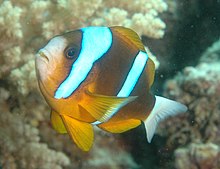Amphiprion akindynos
| Barrier Reef anemonefish | |
|---|---|
 |
|
|
Not evaluated (IUCN 3.1)
|
|
| Scientific classification | |
| Kingdom: | Animalia |
| Phylum: | Chordata |
| Class: | Actinopterygii |
| Order: | Perciformes |
| Family: | Pomacentridae |
| Subfamily: | Amphiprioninae |
| Genus: | Amphiprion |
| Species: | A. akindynos |
| Binomial name | |
|
Amphiprion akindynos (Allen, 1972) |
|
Amphiprion akindynos, the Barrier Reef anemonefish is a species of anemonefish that is principally found in the Great Barrier Reef of Australia, but also in nearby locations in the Western Pacific. The species name 'akindynos' is Greek, meaning 'safe' or 'without danger' in reference to the safety afforded amongst the tentacles of its host anemone. Like all anemonefishes it forms a symbiotic mutualism with sea anemones and is unaffected by the stinging tentacles of the host anemone. It is a sequential hermaphrodite with a strict sized based dominance hierarchy: the female is largest, the breeding male is second largest, and the male non-breeders get progressively smaller as the hierarchy descends. They exhibit protandry, meaning the breeding male will change to female if the sole breeding female dies, with the largest non-breeder becomes the breeding male. The fish's natural diet includes zooplankton.
Adults are an orange-brown color with two white bars with black edging encircling the body. The first bar is located on the head behind the eyes and may be thin and broken. The second bar is on the body below the dorsal fin. The caudal peduncle and caudal fin are white. Juveniles are normally brown with three white stripes. In sub-adults the coloring changes to a dull yellow with two white stripes. They have 10 to 11 dorsal spines and 2 anal spines. They reach a maximum length of 12–13 cm (4.7–5.1 in).
Some anemonefish species have color variations based on geographic location, sex and host anemone. A. akindynos does not show any of these variations.
The white bars on A. akindynos are generally narrower than A. clarkii and lacks the abrupt transition between the body color and white caudal fin. A. clarkii may have a yellow caudal fin. Adult A. chrysopterus are darker while the head bar is broader and not constricted or discontinuous. Traditionally A. akindynos was included in the clarkii complex, however genetic analysis has shown that it is significantly different from any of the other species in the clarkii complex and instead is part of a clade with A. mccullochi. Further study suggested an evolutionary connectivity among between samples of A. akindynos and A. mccullochi. Historical hybridization and introgression in the evolutionary past resulted in a complex structure. There were two evolutionary groups with individuals of both species detected in both, thus the species lacked reciprocal monophyly. There were no shared haplotypes between species.
...
Wikipedia
